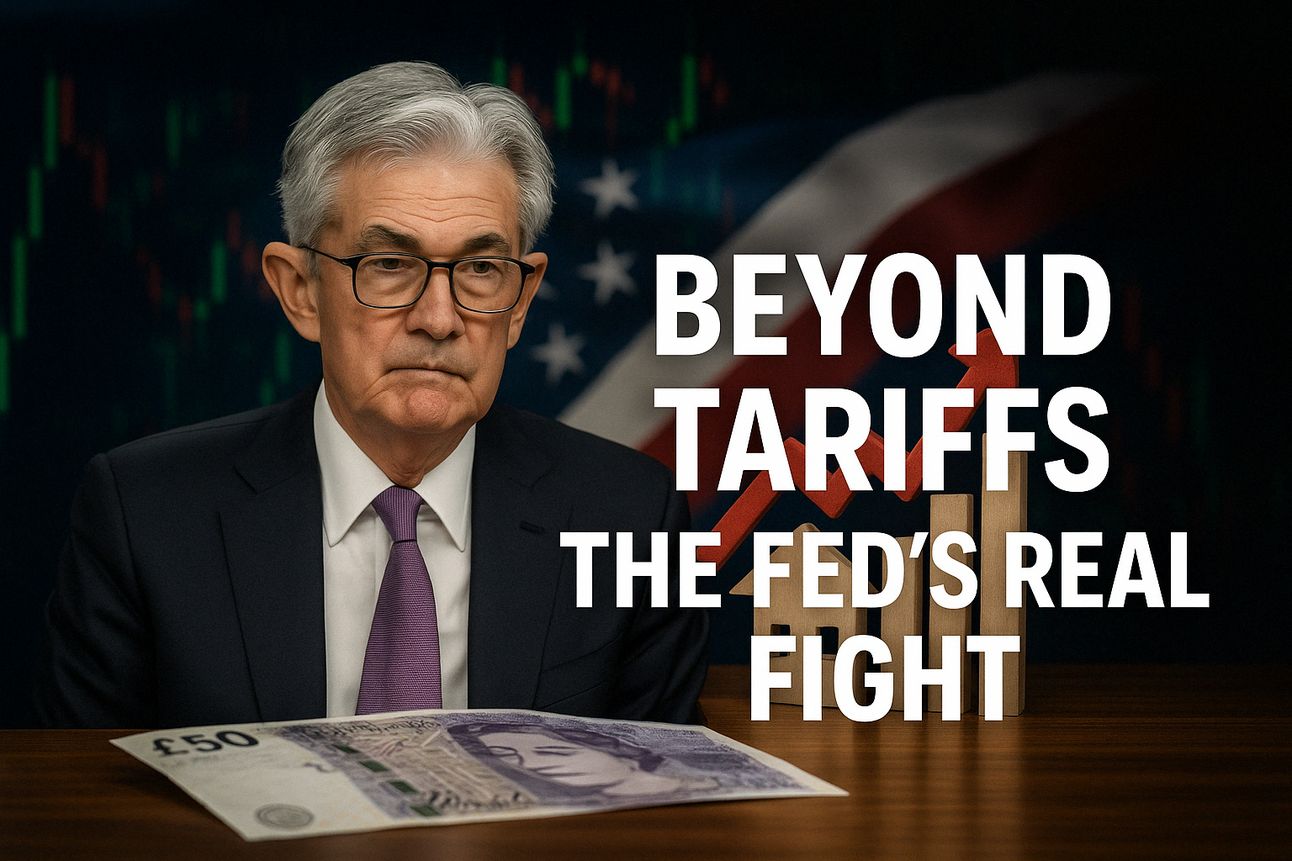The financial world is fixated on tariffs again, and rightfully so. President Trump’s recent return to protectionist policies has revived the trade war narrative, throwing global markets back into volatility mode. But if you zoom out, tariffs are only part of the story.
Underneath the headlines, a more complex battlefield is shaping up. It’s not just between countries, it’s between mandates. And Jerome Powell is stuck in the middle.
The Federal Reserve is facing a choice that’s becoming harder to avoid: Should it fight inflation with higher rates, or protect jobs and growth by cutting them?
This is the real trade war. Not between nations, but between economic goals.
The Tightrope Powell Is Walking

In recent remarks, Fed Chair Powell was notably cautious, not just because of inflation data, but because of the policy trap unfolding in real time. Trump’s tariffs are inflationary by nature. They raise the price of imports, weaken supply chains, and often trigger retaliatory moves that disrupt global commerce.
Yet the broader macro backdrop is flashing recession risk. Treasury yields are falling, consumer sentiment is shaky, and job growth, while still solid, is no longer on autopilot.
Here’s Powell’s dilemma in plain English: If the Fed continues to focus on keeping inflation down, it risks tightening into a slowdown. But if it prioritizes employment and cuts too early, it could reignite inflation at a time when pricing pressures are already returning via tariffs.
That tension isn’t theoretical, it’s now policy reality.
Traders: Don’t Treat Tariffs as a One-Off Event
Many retail traders look at tariffs as a headline spike for commodities or risk-off currency plays. And while that’s not wrong, it misses the strategic layer.
Tariffs aren’t just a pricing tool. They’re a signal, a deliberate attempt to reshape economic alliances, shift supply chains, and force domestic consumption. That’s inflationary. But it’s also deflationary if the retaliation leads to demand destruction.
And here’s the kicker: The Fed can’t control tariffs, but it has to respond to them. This creates a reactive policy loop.
Example? If Trump imposes a 125% tariff on Chinese semiconductors and Beijing retaliates by taxing U.S. agriculture or cutting rare earth exports, what happens?
U.S. businesses face margin pressure.
Consumers see higher prices.
The Fed faces pressure to ease as growth slows.
So tariffs force the Fed’s hand, even if they're politically driven and outside its control.

The 1970s Echo Chamber
We’ve seen this kind of dilemma before.
Back in the 1970s, under Chairman Arthur Burns, the Fed allowed inflation to spiral in part due to political pressure and the oil price shock. The result? A decade of stagflation that was only broken by Paul Volcker’s aggressive rate hikes in the early 1980s.
Powell knows this history well. But the context now is different, debt levels are far higher, and global interdependence makes unilateral action riskier.
This time, the Fed is trying to act preemptively. The market is pricing in three rate cuts in 2025, even as Powell hesitates to confirm them. But that’s where traders should be careful.
The Fed’s dual mandate isn’t just a slogan. It’s a balancing act. Tariffs are tilting the scale. And if inflation proves sticky while job losses start to creep in, Powell may be forced to choose between bad and worse.
source: 1970’s Echo Chamber
Tariff Talk Is Overshadowing the Real Threat

Let’s get blunt: The market is too focused on the direct impact of tariffs and not enough on the second-order effects.
Yes, 125% tariffs on Chinese goods make headlines. But what happens when those goods are components in U.S. manufacturing? What happens when supply chains adapt, but at a higher cost?
And how does that reshape global demand for the U.S. dollar? If allies like Japan, South Korea, and the EU face long-term trade strain, does that accelerate the push toward de-dollarization or regional alternatives?
These are structural shifts. Not just volatility events.
Traders who focus only on short-term reactions risk missing the tectonic policy shifts underneath.
What Could This Means for us Forex and Gold Traders?
For gold, the narrative has shifted. It's no longer just about inflation, it's about the credibility of U.S. monetary policy. If markets sense that the Fed is under political pressure or constrained by fiscal noise, gold tends to gain ground.
The Japanese yen and Swiss franc remain the go-to safe-havens in periods of trade turbulence. The yen, in particular, continues to strengthen as rate differentials narrow and global risk appetite fades.
The U.S. dollar, interestingly, might weaken even if the Fed holds rates steady, especially if traders expect easing down the line and begin pricing it in ahead of the Fed’s confirmation.
Emerging market currencies are at risk, especially those closely tied to China’s manufacturing base or highly dependent on U.S. trade. These currencies may face outsized volatility as trade uncertainty drags on.
Powell’s Most Important Job Right Now

More than managing rates, Powell’s real task is managing credibility.
If the market starts to believe the Fed is no longer independent, or worse, reactive to political trade moves, it could lose its pricing power. Inflation expectations may become unanchored, and rate decisions could lose their intended effect.
This is why Powell’s tone matters as much as the decision itself. If he sounds too dovish, the market will assume he’s caving to pressure. Too hawkish, and he risks overshooting in a softening economy.
It's a lose-lose communication challenge.
Final Thought: Tariffs Are the Fire, the Fed Is the Firefighter
To be clear, tariffs matter. They hit prices. They change behavior. They can collapse industries. But they’re not the whole war.
They’re the fire. The Fed? That’s the firefighter.
And right now, Jerome Powell is walking into a burning building with a hose that may or may not work the way it used to. Traders need to understand both the flames and the response, or risk getting scorched by headlines while missing the long-term structural shift underway.

